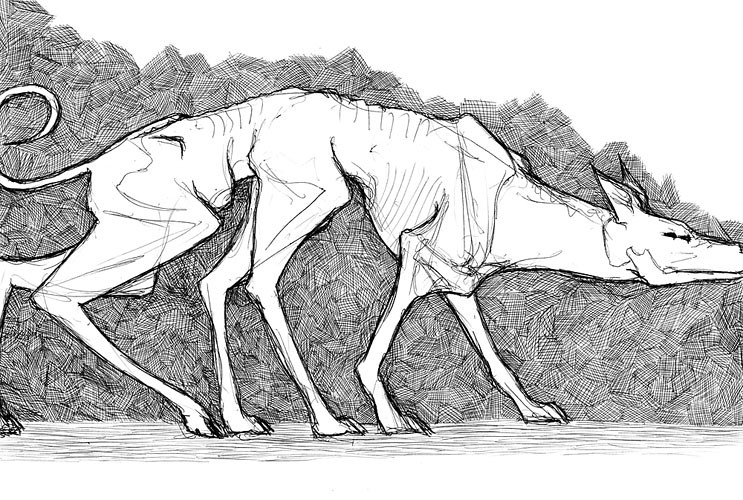Gaunt Hound
The Gaunt Hound, also known as the Great Wolf, Six-wolf and Ug'wen Varga in Goblin is an enourmous species of Canine found on the northern half of Talioche. Aside from its massiveness (standing at just under two metres on average), it is immediately recognisable for its distinctive thinness, and the extra pair of legs that emerge from it's body just below the ending of its ribs.
Basic Information
Anatomy
Gaunt wolves have a thin, sleek profile, with wiry muscles spread out over long lengths keeping them together. Their entire muscular and skeletal system are designed too enable brief but extremely powerful bursts of energy, even allowing the recovery of over strained muscles and bones.
They have a slightly flattened skull, resembling closer to a jackal than a wolf. Their shoulders and torso are similar to most other canines, baring some additional mobility in the shoulder, and larger, more heavily clawed paws on the front legs.
Most distincively, they have two sets of back legs, with hips at just below the ribs and a second set further down an elongated spine. This extra stability allows them to navigate uneven terrain comfortably, and reach a very swift pace on flat terrain, but lack the extra flexibility and claws of their forelegs.
Their skeletons have multiple muscle anchors, some even multiple on single muscle strands, acting as redundancies in the case of muscle tearing. The extended spine gives them considerable flexibility and ability to twist and climb almost snake like.
Dietary Needs and Habits
Gaunt Wolves are carnivores, and usually ambush predators. They are versatile with hunting strategy and prey, hunting everything from deer too birds and fish. Though typically shy of sentient species, they do occasionally prey on hunters, other monsters, and even the undead.
For their most common prey, elkand goats, they tend to take up ambush positions along game trails or nearby sources of water, and lunge out, delivering a fatal bite too the spine, skull, or throat. If such a clean target is unavailable, they target the spine to disable the prey.
Birds and climbing creatures, they usually hunt at night, climbing or jumping into too the secluded perches or reaching into hollows with their clawed forelimbs.
As they are almost incapable of putting on fat, they often take prey back to their lair, and ration eating it over a long period of time. Their extended lower body contains a long and advanced intestine, which is capable of gaining the maximum nutrients from any meal source, and copes remarkably well with rotting flesh and poison.
Additional Information
Social Structure
Gaunt Hounds are solitary creatures, though not particularly territorial. It is unusual for members of the species to fight. They only seek out the company of others during their mating season which is in late autumn.
Facial characteristics
Compared too other canines, they have a slightly flattened skull and a wider jaw. The jaw bones are pronounced jawbones give extra mobility in the jaw, and extra muscular anchors points to allow for a precise and powerful bites. The teeth are less less pronounced than many other species, but the small incisor size allows them too accurately attack vulnerable areas on their prey.
Average Intelligence
The intelligence of Six-Wolves is a hotly debated topic, but they seem to rank in intelligence somewhere between a regular wolf and a Worg. They don't have a recognisable language of their own, but communication amongst themselves can be quite complex.
They have been seen using simple tools in their jaws, and baiting ambushes with the remains of their meals.
Scientific Name
Canis Sixis
Lifespan
70 years
Average Height
1.9 metres
Average Weight
300 kilograms
Average Length
3.4 metres
Average Physique
Gaunt Wolves have almost no epidermal fat, and only thin layer of fur. They are lithe and muscled, and tend to be much lighter and nimbler than their size would show at first glance.
Body Tint, Colouring and Marking
Gaunt Wolves are usually a combination of light grey and brown fur in summer, and grey and white in winter. Some members of the species have darker fur, and seem to have a greater preference for hunting at night.
Geographic Distribution



Comments